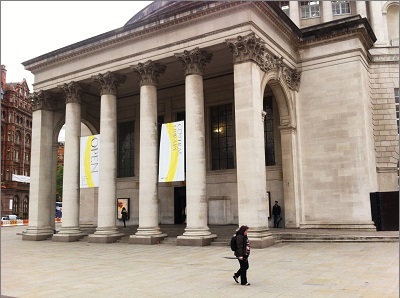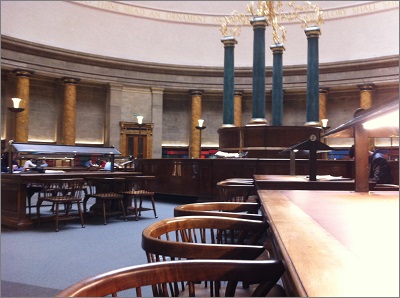
Parthenon memories: one of Manchester's declarations of cultural intent
The best of times, the worst of times: Manchester Central Library revisited
Manchester Central Library has collected awards and plaudits from all quarters since it reopened after a complete renovation. The Leisure Review dropped in to see what a library inspired by the Pantheon looks like when reinvented for a modern age.

Parthenon memories: one of Manchester's declarations of cultural intent
It had, of course, been raining so the new paving laid around St Peter’s Square was bright and slick. Barriers and signs surrounded the areas being dug up and refitted, guiding pedestrians around the works towards the tram stop and the shops. Viewed across the fencing and the temporary walkways, Manchester Central Library looked reassuringly unchanged: imposing and grand with its columns and dome, its grey stone solid and austere. That the building is a monument to the civic might of a great city was clear but its purpose, from where we were standing, was not immediately obvious.
On closer inspection the banners hanging from the portico, the only colour on the front of the building, are there to counter these first impressions. This building is open, they announce, and this is a library: come inside. Closer still and more banners, as big and as numerous as the signs for any of the building’s other services, advertise the café. In a moment we will see why.
The grandeur of this building is no accident or architectural indulgence. When it was first opened Manchester Central Library was a declaration and a statement of intent: this is a city with a great history and great wealth, and its future will be even better than its past. Manchester was the first city to respond to the 1850 Public Libraries Act, opening the Manchester Free Library in 1852. By 1926 the library had moved to several new premises and the city council announced a competition to design a new central library and an extension to the town hall. A scheme by E Vincent Harris, which echoed the Pantheon in Rome and the classical style of library building then prevalent in America, was selected and work began in 1930. The prime minister, Ramsay MacDonald, laid the foundation stone and in July 1934 King George V declared it open, telling the attendant public that “the Corporation have ensured for the inhabitants of the city magnificent opportunities for further education and for the pleasant use of leisure”.
And there it stood, part of Manchester’s noble cityscape, serving the people of the city into a new millennium. By this time it had become increasingly obvious that the library was in need of renovation but a 2008 report into the state of the building made it clear that the situation was now urgent. Dire as the situation appeared, the council recognised that an extensive refurbishment would offer the opportunity to remodel the building and provide the modern facilities that the city’s flagship library desperately required. Manchester Central Library was closed in 2010 and work began.
Four years and almost £50 million later Manchester Central Library reopened to the public. Some described it as a refurbishment, others as a rebuild but whatever terminology you prefer it is clear that this is a building transformed. Approaching across St Peter’s Square, through the portico and the Shakespeare Hall which serves as an atrium, the visitor comes into the main library space on the ground floor. It is circular in shape and grand in scale but the touch screens, open spaces and seating suggest that this is no traditional library. The café occupies a big swathe of space, making it clear that this is a place to meet and talk, as well as all the other things you might expect to be able to do in a modern library.
Among the screens and people (and it is noticeable that here, not far from the main entrance, there are lots of people) are what appear to be strangely enclosed sofas. On closer inspection this is the BFI (which used to be known as the British Film Institute) Mediatheque, which consists of seating pods in which visitors can access and view an extensive film archive. These super-sofas also serve as small meeting areas, curved nooks in a curved space, offering a little seclusion in a very public room.
Stepping further into this room there are plenty of books on open shelves, certainly enough to reassure to the library traditionalist, and lots of screens offering access to library services, introductions to some of the displays and guidance to the other facilities available within the building. This is a busy part of the library but, while far from hushed, it is still surprisingly quiet given the number of people moving in and around the shelves and café. Coffee is being ordered and drunk. Conversations are taking place. Books are being read and notebooks are being written in. A man is reading a Kindle.
Elsewhere on the ground floor you can find a performance space, the archive and special collections search room, the North West Film Archive, the Manchester and Lancashire Family History Society help desk, and the media lounge. Meanwhile, the lower ground floor has more books and more shelves, along with big seating areas and desks. This is the public lending library and it feels more like the engine room of the building. Staff are visible but more numerous are the automatic lending and returns machines, scanning the barcodes of books and borrowers. Periodicals and papers are being pored over. The children’s area is being bounced in and crawled over. There is an exhibition space, banks of computers and, down the corridor, the Ahmed Iqbal Ullah race relations resource centre.
Up on the first floor there are more computers, the history periodicals section and the Henry Watson music library. Following the curved routes of the building’s spaces, we browse among the music shelves: the biographies, journals and scores of the great names of the classical and popular canon. In the corner someone plays the piano silently, headphones plugged into the electronic keyboard. Drums, digital music labs and music streaming are all available.
Climbing the stairs, we find the information and business sections on floor two. Notices offer intellectual property advice workshops and booking procedures for the corridors of meeting rooms that are available to individuals and community groups. On floor three there are yet more meeting rooms and more computers, on floor four the packed shelves of the reference section. Having reached the top, the new clear-glass lift system makes travelling between the floors a simple exercise-free exercise and provides an excellent vantage point from which to appreciate the scale of the project.
To spend an hour wandering the shelves and corridors of this venerable but rejuvenated institution is to understand why the project to reinvent Manchester Central Library has been so widely celebrated. Awards and plaudits have been bestowed, including the 2015 Construction News judges’ supreme award, which noted in its citation that this was a highly complex project completed on time and on budget. The project contractors, Laing O’Rourke, emphasised that a vital aspect of the project’s success was a “strong vision from Manchester City Council and close collaboration and transparent partnership working from the wide range of organisations involved”. It was, the judges decided, a project that “had it all”.
Modernised, reimagined, recreated perhaps, but this Grade II* building has retained its grandeur and its spirit. If the soul of the building is to be found anywhere, it is surely in the Wolfson reading room on the first floor. Here is the dome that gives the building its shape: the spectacularly curved centre of scholarly endeavour that is both ornate, with its marble columns and gilded sculptures, but also austere in its hard-seated chairs and the hardwood desks that radiate like spokes from the hub of the librarians’ central station. Now unstaffed, the librarians’ desk is, like the rest of the room, silent. There are plenty of people dispersed around the huge space but all are bowed in muted endeavour. Above their heads an inscription from the Old Testament that runs around the edge of the dome reads: “Wisdom is the principal thing; therefore get wisdom, and with all thy getting get understanding. Exalt her and she shall promote thee; she shall bring thee to honour when thou dost embrace her, she shall give of thine head an ornament of grace, a crown of glory she shall deliver to thee. Proverbs 4:7.”
There are screens and books on the desks, the sound of keyboards tapping and pages turning. A pen falling on to the desk echoes; a bag dropped on to the floor is an unwelcome but uncensured punctuation. This is a room that feels exclusive but only by dint of self-selection. It is open to any member of the public but this is where the scholars sit: to work and to learn; to strive and aspire; to imagine and dream. They are scholars because they choose to be scholars. They are scholars by virtue of the desks at which they sit and the dome under which they work. They sit among the minds and the multitudes that have sat on these seats before them to write their futures and their pasts.
In its shape and its shadows, the Wolfson reading room is reminiscent of the great libraries of the nation – the dome of the reading room at the British Library before it moved to St Pancras, the reverential hush of the Bodleian at Oxford – but that anyone can walk in from the street and take their place at such a desk surely puts Manchester Central Library among the greatest.
This is a library for a new age. Its roots are obviously in the history of the Public Libraries Act, steeped in public service and civic duty, but its mission is now translated and refined by evolution of our social, political and technological age. It is open and accessible, inclusive and encouraging, while reminding every visitor of the possibilities and perhaps the responsibilities of betterment. Among the marbled columns and shelved learning, the computer screens and the endless connectivity, there is the potential for inspiration and endeavour; or even repose and recreation. Never would idle contemplation be so fulfilling or so worthy.
The context of the Manchester Central Library refurbishment project was one of central government funding cuts to local authorities and the continuing battle over the future of the public library service. These struggles have been as obvious in Manchester as anywhere else in the country, with local libraries closing, opening hours restricted and library staff replaced by volunteers. While the number of visitors to the central library trebled on reopening, there were reports of a drastic decline in usage of libraries around the city. While the city’s flagship library flourishes, elsewhere the cuts have been deep with the council cutting a reported £250 million from its 2011-15 budgets.
A visit to Manchester Central Library is an undoubted joy but it also serves to remind us that these are the best of times, these are the worst of times. This library is an illustration of the best of what libraries are, an example of what they could be and a reminder of what they should be. Libraries are, could and should be beacons of learning and of light, of accessibility and equality, of the possible and the best. There was a time when all libraries were going to be like this, when councillors and members of parliament, kings and presidents were determined that all libraries should be like this. But not now; and not any time soon.
The Leisure Review, October 2015
© Copyright of all material on this site is retained by The Leisure Review or the individual contributors where stated. Contact The Leisure Review for details.
![]() Download a pdf version of this article for printing
Download a pdf version of this article for printing
